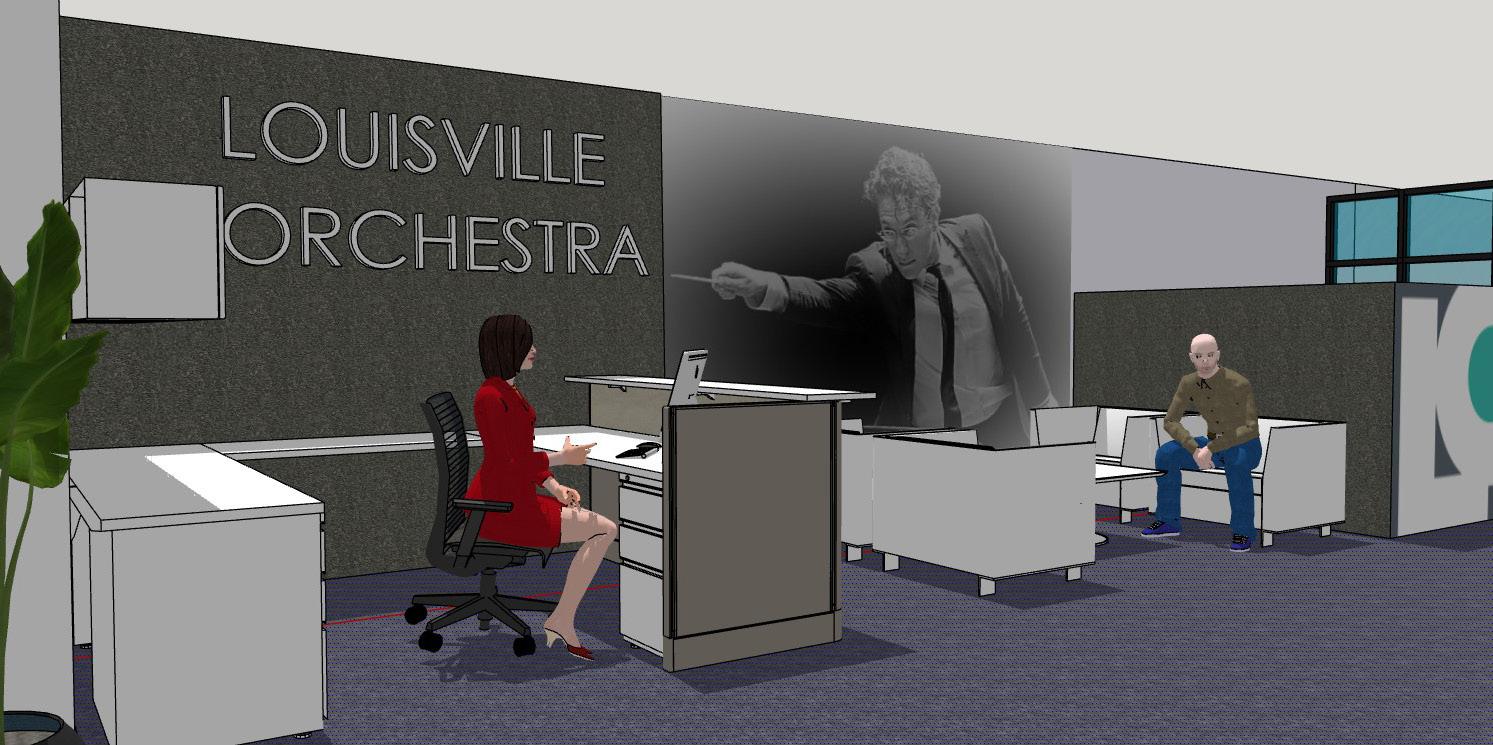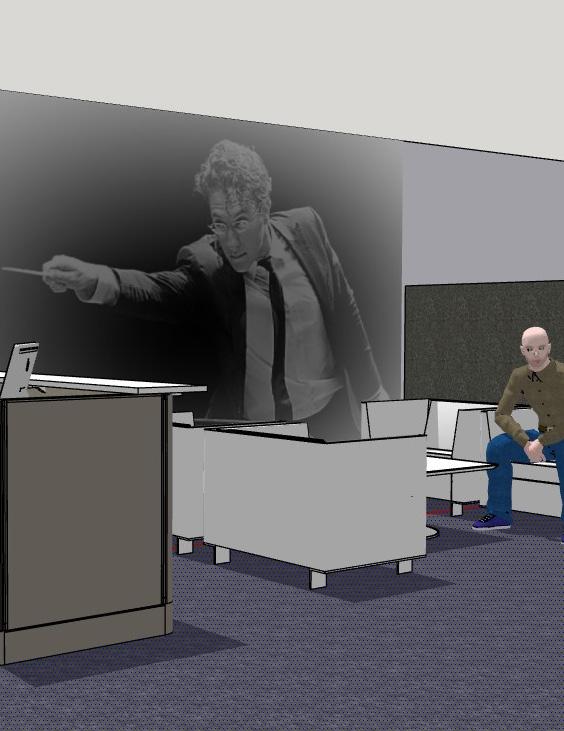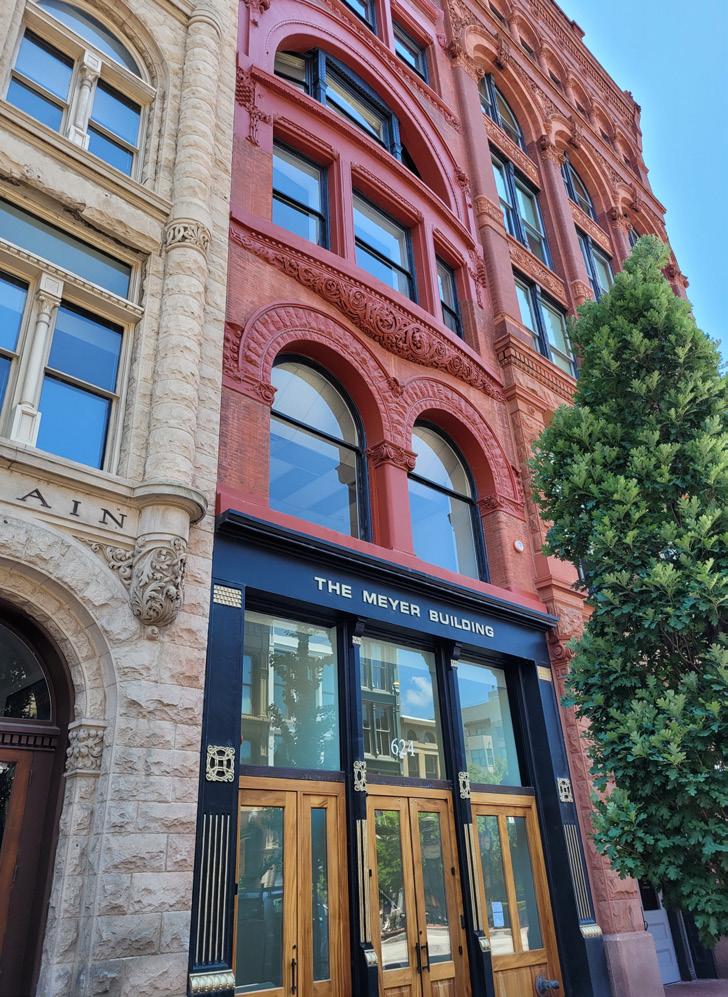
9 minute read
LOUISVILLE ORCHESTRA LO Moving to a Viewable and Visitable New HQ
MAKING THEIR MOVE

Advertisement
LOUISVILLE ORCHESTRA TO OPEN A VIEWABLE & VISITABLE NEW HEADQUARTERS ON MAIN STREET
he Louisville Orchestra is going places. But not far. Actually, it’s the office and administrative staff of the symphony that’s moving to new quarters, keeping up with the musical growth of the orchestra.T The office is trading space on one floor at 620 W. Main St. for three floors next door at 624 W. Main — creating a custombuilt headquarters with room enough for the entire staff, and a chance for visitors to find out what “the world’s most interesting orchestra” is up to now. “We’ll be on three floors now in a beautiful, historic building on Main Street,” says Graham Parker, CEO of the Louisville Orchestra. “We’re going to have a big sign on the building and real visibility on Main Street for the first time.” The tall brick buildings of the 600 block of West Main stand in a distinctive row along what once was Louisville’s busiest business street. A century later, West Main is thriving again in a splendid rebirth of business, and arts and entertainment. And the orchestra’s new headquarters is just a block west and across the street from its performance home in Whitney Hall in the Kentucky Center. Known as the Meyer Building, 624 W. Main St. was designed in 1880 by renowned Louisville architect Charles D. Meyer. We’ll be on three floors now in a beautiful, historic building on Main Street. We’re going to have a big sign on the building and real visibility on Main Street for the first time.
− Graham Parker, CEO, Louisville Orchestra
It’s typical of its neighbors on the National Register of Historic Buildings, with a decorative cast-iron front at street level leading to a stylish high capitol six stories above. Plate glass windows reflect the image of similar buildings across the street. (One of those housed the orchestra’s offices a half century ago.) “We were made aware of the building by its owner, Mo Deljoo, who offered us the opportunity to become the primary tenant and help establish the building’s identity as it is renovated,” Parker says. Deljoo is Manager Director, Noveen Holdings, LLC, Noveen Management Inc. “Mr. Deljoo is a Louisville Orchestra supporter and believes in investing his resources with the community. We saw the potential and just went for it.”
Digital rendering of the LO's new lobby in the Meyer Building on Main Street, courtesy of Louisville Orchestra.
The Meyer Building, 624 W. Main St., was designed in 1880 by renowned Louisville architect Charles D. Meyer and will be the new home of the Louisville Orchestra.

The move will be accomplished through the summer, with an opening planned for fall, soon after the Louisville Orchestra launches its 85th season in September.
“Right now, everybody is scattered hither and yon while the work is going on,” says Carla Givan Motes, the LO’s Director of Patron Services and Ticket Manager. The ticket office, for example, is camped at the nearby Glassworks Building. “But once we get through the changes and learn the shiny new tools, and begin clicking along through the season, I think everything’s going to be great — for the staff, and for patrons.”
Motes says a new website will offer improved electronic ticketing capacity, including print-at-home options, active accounts that can be managed by the patrons, automatic discounts applied for subscribers, and other features. But she’ll still be live and in person to help patrons select the seats they wish. In fact, she says, the new building should foster more contact between the staff and the orchestra’s loyal listeners.
“We have board members who have never been to our office because board meetings have to be held at a more spacious site,” says Motes. "So, with a place to gather together, the staff and board members will have the chance to work together even more effectively."
"And,” she adds, “a lot of times, the staff, except for the senior team, never gets to know our board members. I’ve always felt that that’s important. And now, we have the opportunity to make it happen.”
Parker, a Peabody Award-winning music executive with Universal Music Group and Decca Records, and a former general manager of WQXR-FM in New York, has a strong relationship with LO’s Music Director Teddy Abrams. He signed Abrams and the Louisville Orchestra to a Decca contract before coming to Louisville as interim CEO.
A native of Great Britain, Parker has worked in the United States for 26 years, with deep connections in the classical music world. (That’s Beethoven and Brahms, but also show business.) And that’ll probably be reflected in the Louisville Orchestra’s new headquarters — starting with that sign on the building, and an invitation to come inside.
“We’re investing in the greatest staff we can attract and retain, and providing them with an office space that is modern and contemporary — yet also welcoming for the community,” says Parker. “We’re right downtown on Main Street for people to come on up and feel comfortable in visiting. The reception area is on the fourth floor. We’ll have plenty of wall space to maybe showcase local artists. We have a beautiful new music library, and it’ll all be very inviting for meetings and gatherings of supporters.
In all, he says, reflectively, “It feels important.”
A MAGNET ON MAIN STREET
Over 85 years, the Louisville Orchestra has operated with many office locations.
Personnel Manager Adrienne Hinkebein came on with the orchestra when its offices were located in the Finley Building at 300 W. Main at the corner of Third and Main streets, the present
location of the BBC Brewery. At first, the orchestra office was on the downstairs floor, a few steps from street level, like a jazz club in Greenwich Village.
“We moved upstairs then, taking over the first and second floors, and that was a really nice space,” recalls Hinkebein. “Our conference room was on the first floor, looking out over the corner intersection. The LG&E building was right there, and it felt like we were in the center of things. There were big windows with awnings, and the windows said, ‘Louisville Orchestra.’
“People would walk by, and drop in,” she recalls. “I remember people would come into town for concerts and be, like, ‘Oh my gosh, I know all about the (orchestra’s) First Edition records. Can I buy a record? Is there a library I can see?’ And I’d sell them a record. This was about 1999, 2000, before I was Personnel Manager. A totally different era.”
But an era of visibility for the orchestra. Right there at Third and Main. A visibility the orchestra hopes to create in its new building.
French horn player Steve Causey goes back a building before that, recalling when he joined the orchestra in 1970, its office was at 609 Main St., across the street from its new location. “The players didn’t get by the offices very much, of course,” he says. “We rehearsed and played at The Kentucky Center. Jorge Mester was my first conductor. But I did like to get over to the office occasionally.”
That office was expanded to include space next door at 611 Main St., with a walk-through between the connected buildings.
Following chronologically, then, the orchestra moved from 609-611 to the Third and Main location Hinkebein mentioned. Then, through an initiative of the Fund for the Arts, the orchestra joined with Kentucky Opera and Kentucky Shakespeare to occupy several floors in the Brown Building on Main Street called ArtsSpace.
One problem with the Brown was it was too far from Whitney Hall. The orchestra was there for 10 years, until moving closer to The Kentucky Center in the location it just vacated, at 620 W. Main, the Doe-Anderson Building.
It’s been an attractive space, with beautiful views of the Ohio River, but not roomy enough to house all the orchestra staff and operations. The music library, for example, has been located out of sight on a lower level of The Kentucky Center. Now, it’s headed into the new building, with the rest of the orchestra.
AN OFFICE IN A FILE BOX?
That’s the “modern era” of the orchestra offices, since 1971. But before that, back to the orchestra’s founding in 1937, things were sketchy.
We do know that for a number of years, the orchestra had its offices in Memorial Auditorium, at Fourth and Kentucky streets. The orchestra played there before relocating for better acoustics at Columbia Auditorium, at Spalding University. That’s probably because there wasn’t an original “office” of the Louisville Orchestra. The business of the symphony was handled by just a few people — because there were just a few people to run it. Any funds the orchestra had were “poured” into slim salaries and performance fees for the musicians.
Dann C. Byck, the owner of the fashionable Byck’s women's clothing store, headed the search team that hired Robert Whitney, of Chicago, to come to Louisville in 1937 to found a quality orchestra. Byck, and his very orchestra-active wife, Mary Helen, may have handled much of the business matters in those startup years. Fannie Brandeis corresponded with friends in the national musical world to help the cause, as did Mrs. Morris Belknap, University of Louisville music school dean Dwight Anderson, and others. But the notion here is the orchestra was born before its first business office.
Money, of course, was very scarce in 1937, in the Depression Years, and one imagines most of the orchestra’s business files were housed in a file box that got moved around among the early activists. Whitney and his wife, Clarita, probably ended up with the box and the checkbook for a very slim checking account. Whitney had said in his recruitment by the orchestra committee that he had business and management experience in his day job in Chicago managing an artistic initiative of Works Progress Administration (WPA). (We’re just speculating on that file box. Further research is required.)
Whitney noted in his memoirs that he was delighted when violinist Robert Hist volunteered to keep the books. Eventually the Louisville Civic Symphony, as the orchestra was originally called, hired John Snowden as its first manager. Snowden was succeeded in 1948 by John Woolford, from the New York Philharmonic, and then Richard Wangerin, a professional manager from Kansas City, who continued with Whitney through the maestro’s 30-year tenure.
But where were the offices?
We came across one note in Carole Birkhead’s history of the Louisville Orchestra that in 1947, the orchestra had an office at 228 Guthrie St., above the Durand store.
Probably all the offices were similarly downtown.
On a personal note, this writer remembers walking with my dad, Bill Doolittle Sr., a cellist in the symphony, one day on Walnut Street (now Muhammad Ali Boulevard). We bumped into Mr. Wangerin, who shook hands and explained what an orchestra manager did, and how there is a whole set of people who help the conductor and the players put on the show.
So, there’s a call to action to find out more about those days, and who, how, and where those people did the behind-thescenes work of the Louisville Orchestra.

